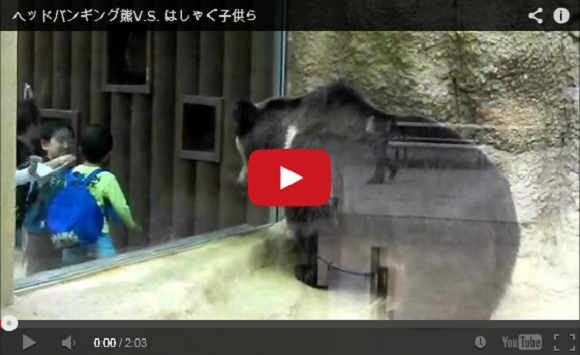
Most of us have been to a zoo at least once. As children, it’s often the highlight of a weekend–watching the prowling big cats, hearing the bellowing elephants, and petting the adorable rabbits–it’s almost too good to be true. Unfortunately, “too good to be true” may be more accurate than we want to admit.
In fact, a certain Japanese video that has recently gone viral due to its “cute” footage shows just how traumatizing zoos can be for their animal residents.
Titled “Headbanging Bear vs Frolicking Students,” the video was shot at Oji Zoo in Kobe in 2011 and shows a Tibetan blue bear interacting with some children giddy with excitement. According to the video description, the bear was in the new bear house, and the animal was “bouncing for some unknown reason, perhaps because of the late autumn heat.” You can check out the video below.
Our more zoologically-inclined readers may have already figured out the problem with this video, and it’s not the little kids tapping on the glass–though that’s certainly nasty behavior. It turns out that the bear’s “headbanging” probably wasn’t simple bouncing for fun or even due to the heat, but more likely an example of stereotypy–which can be most basically defined as repeated and/or ritualistic movements. Stereotypy can be found in both humans and animals, and usually indicates a mental or psychological problem.
With animals, stereotypy is, sadly, extremely common in zoos, usually as a result of animals being kept in improper enclosures or isolated. For example, a report from Oxford summarizing the current state of research stated that up to 40 percent of elephants kept at zoos exhibited some form of stereotypy, though the paper notes that only a few studies have been conducted.
Stereotypical movement itself is not the problem–as one paper from Brown university puts it, stereotypy is “behavior indicative of an abnormal environment.” When animals which typically live in “homes” hundreds of miles across and spend all their time prowling are put in small cages, you can imagine the sort of mental torture they undergo. Just as solitary confinement can have devastating effects on humans, the limited stimulation and inability to express their natural instincts such as foraging can have a significant impact on zoo animals.
▼Both of these elephants are exhibiting stereotypical behavior.
The elephant on the left by swinging its head and “dancing” from back and forth,
and the elephant on the right by pacing the length of the cage.
While there aren’t really any simple answers to this problem–you probably don’t want to just fling the gates open at the lion enclosure at Ueno Zoo and say “Be free!” in the middle of Tokyo–it is something that definitely needs to be addressed. Some solutions suggested by researchers include expanding enclosures, environmental enrichment, and simply removing animals from zoos to be put in sanctuaries. Of course, all of these solutions require a lot of money–and would probably reduce profits for zoos as well, since it would mean fewer animals available to the public.
This is not to say that all zoos or all animals kept in zoos are necessarily suffering–but it is extremely common to find animals locked in inappropriate enclosures. If you spot an animal exhibiting stereotypical behavior in a zoo, there’s not much you can do directly. But you can take videos, contact your local politicians, and try to organize with zoo checking groups like Born Free, with UK and US branches, and ALIVE in Japan.
Sources: Bear Biology, The Independent, RSCPA (UK), Wikipedia, Brown University, ALIVE
Images: YouTube

 Tufts of shed polar bear fur among the gacha prizes at Japan’s newest crazy capsule toy machine
Tufts of shed polar bear fur among the gacha prizes at Japan’s newest crazy capsule toy machine Adorable baby ape born at Japanese zoo…to mom who lives alone
Adorable baby ape born at Japanese zoo…to mom who lives alone Herp derp! Awkward sun bear is awkward, somehow still adorable【Photos】
Herp derp! Awkward sun bear is awkward, somehow still adorable【Photos】 Maruyama Zoo tries to mate two spotted hyenas for four years, recently learns both are males
Maruyama Zoo tries to mate two spotted hyenas for four years, recently learns both are males Japanese zoo’s “Smoker Enclosure” sign taken down
Japanese zoo’s “Smoker Enclosure” sign taken down McDonald’s new Happy Meals offer up cute and practical Sanrio lifestyle goods
McDonald’s new Happy Meals offer up cute and practical Sanrio lifestyle goods All-you-can-drink Starbucks and amazing views part of Tokyo’s new 170 meter-high sky lounge
All-you-can-drink Starbucks and amazing views part of Tokyo’s new 170 meter-high sky lounge More foreign tourists than ever before in history visited Japan last month
More foreign tourists than ever before in history visited Japan last month Beautiful Sailor Moon manhole cover coasters being given out for free by Tokyo tourist center
Beautiful Sailor Moon manhole cover coasters being given out for free by Tokyo tourist center Starbucks reopens at Shibuya Scramble Crossing with new look and design concept
Starbucks reopens at Shibuya Scramble Crossing with new look and design concept Is the new Shinkansen Train Desk ticket worth it?
Is the new Shinkansen Train Desk ticket worth it? Beautiful new Final Fantasy T-shirt collection on the way from Uniqlo【Photos】
Beautiful new Final Fantasy T-shirt collection on the way from Uniqlo【Photos】 Randomly running into a great sushi lunch like this is one of the best things about eating in Tokyo
Randomly running into a great sushi lunch like this is one of the best things about eating in Tokyo Hanton rice — a delicious regional food even most Japanese people don’t know about, but more should
Hanton rice — a delicious regional food even most Japanese people don’t know about, but more should Arrest proves a common Japanese saying about apologies and police
Arrest proves a common Japanese saying about apologies and police Disney princesses get official manga makeovers for Manga Princess Cafe opening in Tokyo
Disney princesses get official manga makeovers for Manga Princess Cafe opening in Tokyo We try out “Chan Ramen”, an underground type of ramen popular in the ramen community
We try out “Chan Ramen”, an underground type of ramen popular in the ramen community Foreign English teachers in Japan pick their favorite Japanese-language phrases【Survey】
Foreign English teachers in Japan pick their favorite Japanese-language phrases【Survey】 There’s a park inside Japan where you can also see Japan inside the park
There’s a park inside Japan where you can also see Japan inside the park Japanese convenience store packs a whole bento into an onigiri rice ball
Japanese convenience store packs a whole bento into an onigiri rice ball Studio Ghibli releases Kiki’s Delivery Service chocolate cake pouches in Japan
Studio Ghibli releases Kiki’s Delivery Service chocolate cake pouches in Japan Japan’s bone-breaking and record-breaking roller coaster is permanently shutting down
Japan’s bone-breaking and record-breaking roller coaster is permanently shutting down New definition of “Japanese whiskey” goes into effect to prevent fakes from fooling overseas buyers
New definition of “Japanese whiskey” goes into effect to prevent fakes from fooling overseas buyers Foreign passenger shoves conductor on one of the last full runs for Japan’s Thunderbird train
Foreign passenger shoves conductor on one of the last full runs for Japan’s Thunderbird train Our Japanese reporter visits Costco in the U.S., finds super American and very Japanese things
Our Japanese reporter visits Costco in the U.S., finds super American and very Japanese things Kyoto bans tourists from geisha alleys in Gion, with fines for those who don’t follow rules
Kyoto bans tourists from geisha alleys in Gion, with fines for those who don’t follow rules Studio Ghibli unveils Mother’s Day gift set that captures the love in My Neighbour Totoro
Studio Ghibli unveils Mother’s Day gift set that captures the love in My Neighbour Totoro Domino’s Japan now sells…pizza ears?
Domino’s Japan now sells…pizza ears? New Japanese KitKat flavour stars Sanrio characters, including Hello Kitty
New Japanese KitKat flavour stars Sanrio characters, including Hello Kitty Sales of Japan’s most convenient train ticket/shopping payment cards suspended indefinitely
Sales of Japan’s most convenient train ticket/shopping payment cards suspended indefinitely Sold-out Studio Ghibli desktop humidifiers are back so Totoro can help you through the dry season
Sold-out Studio Ghibli desktop humidifiers are back so Totoro can help you through the dry season Japanese government to make first change to romanization spelling rules since the 1950s
Japanese government to make first change to romanization spelling rules since the 1950s Ghibli founders Toshio Suzuki and Hayao Miyazaki contribute to Japanese whisky Totoro label design
Ghibli founders Toshio Suzuki and Hayao Miyazaki contribute to Japanese whisky Totoro label design Doraemon found buried at sea as scene from 1993 anime becomes real life【Photos】
Doraemon found buried at sea as scene from 1993 anime becomes real life【Photos】 Tokyo’s most famous Starbucks is closed
Tokyo’s most famous Starbucks is closed One Piece characters’ nationalities revealed, but fans have mixed opinions
One Piece characters’ nationalities revealed, but fans have mixed opinions We asked a Uniqlo employee what four things we should buy and their suggestions didn’t disappoint
We asked a Uniqlo employee what four things we should buy and their suggestions didn’t disappoint Princesses, fruits, and blacksmiths: Study reveals the 30 most unusual family names in Japan
Princesses, fruits, and blacksmiths: Study reveals the 30 most unusual family names in Japan Studio Ghibli’s new desktop Howl’s Moving Castle will take your stationery on an adventure
Studio Ghibli’s new desktop Howl’s Moving Castle will take your stationery on an adventure Devastatingly cute otters strike again — this time they’re just little babies!【Pics and videos】
Devastatingly cute otters strike again — this time they’re just little babies!【Pics and videos】 Japan has rabbits that cosplay each fall…as other rabbits?!? 【Photos】
Japan has rabbits that cosplay each fall…as other rabbits?!? 【Photos】 Photos of scrawny-looking lion and tiger raise concerns for Beijing Zoo’s big cats
Photos of scrawny-looking lion and tiger raise concerns for Beijing Zoo’s big cats 12-foot python found in Yokohama after evading authorities for 16 days
12-foot python found in Yokohama after evading authorities for 16 days These adorable animal cakes may be too cute to eat, but we’ll still try!【Photos】
These adorable animal cakes may be too cute to eat, but we’ll still try!【Photos】 We knew elephants could paint, but we didn’t expect them to be so good at it!【Video】
We knew elephants could paint, but we didn’t expect them to be so good at it!【Video】 Senpai Mole answers kids’ questions, but is kind of a jerk about it
Senpai Mole answers kids’ questions, but is kind of a jerk about it Social distanced dining is a cinch with these stuffed capybara companions【Photos】
Social distanced dining is a cinch with these stuffed capybara companions【Photos】 The tragic tale of Maruo the Capybara: Zoo’s death announcement sounds like a harrowing drama
The tragic tale of Maruo the Capybara: Zoo’s death announcement sounds like a harrowing drama Charitable bird feeds hungry fish in Miyazaki Prefecture【Video】
Charitable bird feeds hungry fish in Miyazaki Prefecture【Video】 Japanese zoo penguin falls in love with cutout of cute anime penguin girl
Japanese zoo penguin falls in love with cutout of cute anime penguin girl Ape escape! Emergency manoeuvres at Ueno Zoo as world’s least-threatening gorilla gets loose
Ape escape! Emergency manoeuvres at Ueno Zoo as world’s least-threatening gorilla gets loose Japanese sweets maker’s edible zoo and aquarium is filled with creatures almost too cute to eat!
Japanese sweets maker’s edible zoo and aquarium is filled with creatures almost too cute to eat! Heartbroken visitors leave tributes to Japan’s anime-loving penguin Grape-kun at new memorial
Heartbroken visitors leave tributes to Japan’s anime-loving penguin Grape-kun at new memorial Zoo Jeans from Japan uses denim marked with the claws and teeth of lions
Zoo Jeans from Japan uses denim marked with the claws and teeth of lions
Leave a Reply